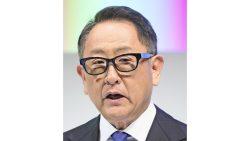15:00 JST, June 10, 2025
As rice prices have continued to soar, there are growing public calls for a shift in established agricultural policies.
The causes and issues behind the increases in rice prices, which have doubled from the previous year, must be identified, and reforms aimed at ensuring a stable supply should be implemented.
A council of relevant Cabinet ministers established by the government intends to consider the future rice policy, but it is first necessary to analyze the causes of the price increases and assess whether the Agriculture, Forestry and Fisheries Ministry’s measures to date have been appropriate.
The council is said to be aiming to reach a conclusion within about a year. As part of mid-term reforms, it would be desirable to reconsider the production adjustment policy that effectively amounts to the reduction of rice paddy acreage. It is also necessary to explore measures for income compensation for farmers who face financial difficulties when rice prices decline as a result of increased production.
It is clear that the ministry misjudged the outlook for rice prices. Price increases began last summer. The ministry had indicated that prices would stabilize once rice harvested in 2024 became available, but prices did not decline and concerns about shortages persisted.
As a result, frustration spread that wholesalers and other businesses involved in the distribution process were hoarding rice due to expectations of continued high prices. It has also been argued that the entry of speculative traders has helped fuel the price surge.
Criticism continues over such matters as delays in releasing stockpiled rice. But where exactly did bottlenecks in the distribution process occur, and why? The ministry’s failure to grasp the reality of how complexly the distribution system operates is a significant problem.
Under the nation’s rice policy after World War II, the government in principle purchased and controlled all the rice produced. Producers became able to sell directly to consumers after the Food Control Law was abolished in 1995, but the government continued to maintain prices through production adjustments led by the state through its policy of reducing rice paddy acreage.
The government abolished the acreage reduction policy in 2018, but to stabilize farmers’ livelihoods, it has provided incentives to encourage farmers to shift to other crops, effectively maintaining the policy. This may have led to a lack of consideration for the consumers’ perspective and delayed responses.
The current rice policy has been in place for about 30 years, and it is obvious that it is unable to respond to unforeseen circumstances such as the current situation.
The importance of food security has increased dramatically due to climate change, the intensification of disasters and the instability of the international situation.
It can be said that the time has come to undertake comprehensive reforms.
The number of people whose primary occupation is in the agriculture industry has halved over the past 25 years, dropping to about 1.1 million. With an average age of about 69, the farming population is growing progressively gray. The number is projected to plummet to 300,000 in 20 years, making the shortage of successors a serious issue.
It is necessary to establish new agricultural policies that include strengthened exports, to stabilize supply by enhancing productivity so that producers can engage in rice cultivation without worries, as an appealing profession.
(From The Yomiuri Shimbun, June 10, 2025)
"Editorial & Columns" POPULAR ARTICLE
-

Mt. Fuji Eruption: Preparations Necessary for Widespread Ashfall
-

Nippon Steel’s Acquisition To Be Approved: Deal Should Be a Symbol of Japan-U.S. Economic Cooperation
-

Basic Economic, Fiscal Policy Draft: Deepen Strategy to Increase Take-home Pay
-

U.S. Tariffs Blocked: Can Judiciary Prevent The President from Abusing Power?
-

With Trump Back, Japan Must Expand Foreign Policy
JN ACCESS RANKING
-

Toyoda to Become Automobile Business Association of Japan Chairman; to Help Guide U.S. Tariff-Affected Industriessns
-

Visitors to Japan Hit Single-Month Record High in April
-

Japanese Researchers Develop ‘Transparent Paper’ as Alternative to Plastics; New Material Is Biodegradable, Can Be Produced with Low Carbon Emissions
-

Japan to Introduce Car Fuel with Up to 10% Biofuels from Fiscal 2028; Limited Rollout Expected at Areas with Refineries
-

Japan’s Core Inflation Hits More than 2-year High, Could Force Year-End BOJ Hike

















